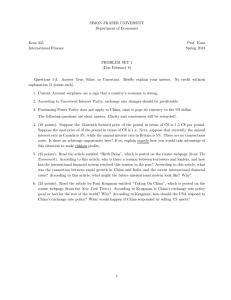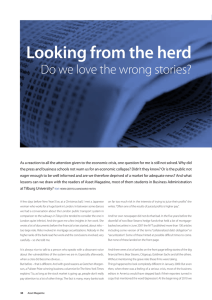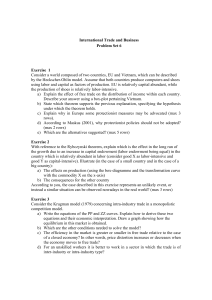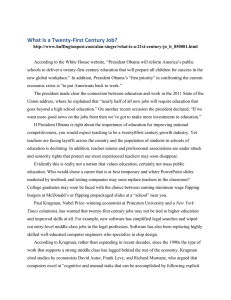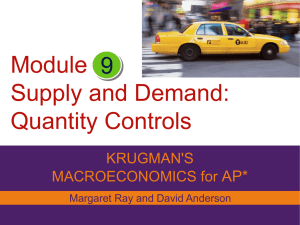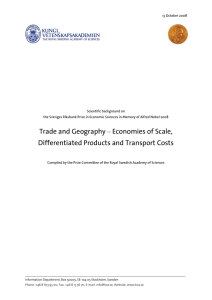Increasing Returns and International Trade Ian Sheldon (Ohio State)
advertisement
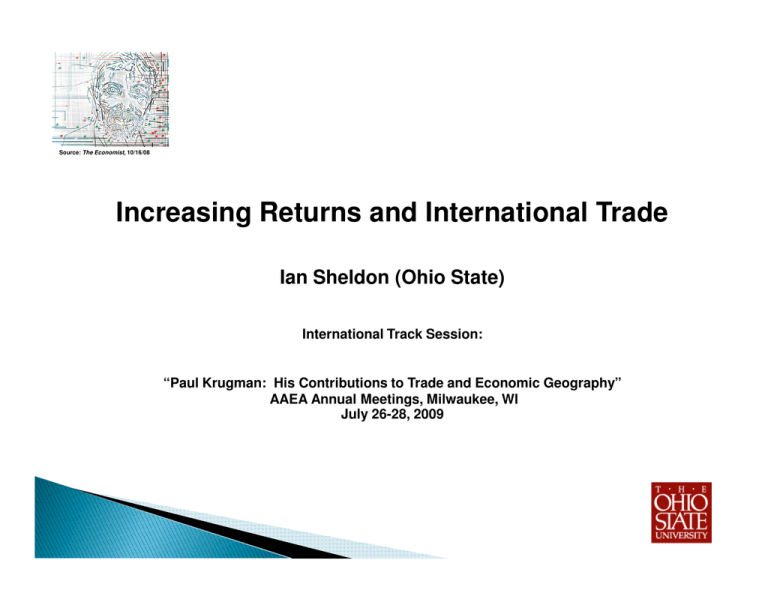
Source: The Economist, 10/16/08 Increasing Returns and International Trade Ian Sheldon (Ohio State) International Track Session: “Paul Krugman: His Contributions to Trade and Economic Geography” AAEA Annual Meetings, Milwaukee, WI July 26-28, 2009 Increasing Returns and International Trade ● Mid-1960s, trade theory dominated by Heckscher-Ohlin model ● Could not account for stylized facts (Dixit, 1993): ■ Trade between countries with similar factor endowments ■ Two-way trade in similar products – intra-industry trade (IIT) ● Grubel and Lloyd (1975), in documenting extent of IIT, argued it could be explained by economies of scale ● Ohlin (1933), and others (Graham, 1923; Knight, 1924), had already recognized role for increasing returns in trade models, but posed awkward problem for theorists – inconsistency with perfect competition Increasing Returns and International Trade ● Attempts to incorporate external economies into generalequilibrium analysis, by Melvin (1969), and Chipman (1970), inter alia – generated a “…bewildering variety of equilibria…” (Krugman, 1995) ● In late-1970s, economies of scale and imperfect competition embedded in trade models – (a) Krugman (1979, 1980) and Lancaster (1979) in one-sector models of IIT, (b) Dixit and Norman (1980), Lancaster (1980), and Helpman (1981) integrating traditional trade theory with IIT ● Scale economies internal to firm, but moderate enough to ensure survival of large number of firms in free-entry equilibrium producing close but not perfect substitutes, i.e., monopolistic competition Increasing Returns and International Trade ● Role of differentiated products recognized by Haberler (1937), but attempts to incorporate monopolistic competition into trade theory unsuccessful (Helpman, 1984) ● Limitation – absence of rigorous treatment of product differentiation – solved in 1970s through two approaches: (i) Dixit and Stiglitz (1977) love of variety, and (ii) Lancaster (1979), preferred variety – both generating aggregate demand for variety ● Krugman drew on (i), Lancaster, and Helpman (ii); how to model preferences essentially unimportant – either approach ends with an equilibrium, characterized by firms with monopoly power earning no monopoly profits (Krugman, 1987) Increasing Returns and International Trade ● Krugman’s (1979) original model: - economy with single factor l, used to produce i = 1,…n goods: l i = α + βi , α, β > 0 - all goods enter utility function symmetrically: n U = ∑ v (ci ), v ′ > 0, v ′′ < 0 i=1 i=1 - workers also consumers, and there is full employment: n x i = Lci , and, L = ∑ (α + βx i ) i=1 - have to solve for: p / w , x , and n (dropping subscript i) - firm’s pricing condition implies: p / w = βε / (ε - 1), dε / dc < 0, giving PP in figure 1 ε = -v ′ / v ′′c , Increasing Returns and International Trade - zero profit condition implies: 0 = px - (α + βx )w , or p / w = β + α / Lc giving ZZ in figure 1 p/w Z P Figure 1 (p/w)0 Z P β c0 c - solving for c, and given x = Lc, number of goods in equilibrium is: n = L / (α + βx ) - number of goods constrained by α Increasing Returns and International Trade ● Allow for another identical economy – doubling L, shifts ZZ curve down to left, lowering p/w and c; direction of trade indeterminate, but there is IIT, and gains from trade due to: (i) increase in output x of each good: x = (ii) and increased variety of goods n: α p/w-β n = L / (α + βLc ) - result dependent on PP sloping up, which depends on elasticity of demand ε rising as c falls, i.e., increased variety results in goods becoming closer substitutes - in Krugman (1980), elasticity held constant, gains from trade being increased variety, with no increase in scale of output Increasing Returns and International Trade ● Subsequent analysis by Helpman and Krugman (1985), used approach popularized by Dixit and Norman (1980), setting monopolistic competition in context of traditional trade theory ● Assume two countries, j and k, two factors, K and L, and two industries: one is competitive producing homogeneous good Y under constant returns, the other monopolistically competitive producing range of goods X = nx under increasing returns ● Also assume Y is labor-intensive, X is capital-intensive, and that countries have common knowledge of technologies and identical, homothetic preferences ● In figure 2, trade in goods reproduces integrated equilibrium, with both inter and intra-industry trade Figure 2: Trade Equilibrium Ok = V Lk B CYk Yk Qj nxk Ck E Kj x ● nXj Kk ● C Cj x Qk Cj Oj Y j Y w/r B Lj Increasing Returns and International Trade ● Krugman (1979) helped pioneer incorporation of increasing returns and product differentiation into trade models “…Remarkably, the paper achieves all of this in only ten pages, and in a very simple and transparent fashion…” (Prize Committee of the Royal Swedish Academy of Sciences, 2008) ● Synthesis allowed incorporation into general equilibrium trade model, and extended application to external economies, intermediate goods trade, vertical integration, and multinational firms (Helpman and Krugman, 1985) ● Also provided foundations for his subsequent increasing returns and geography (Krugman, 1991) work on
